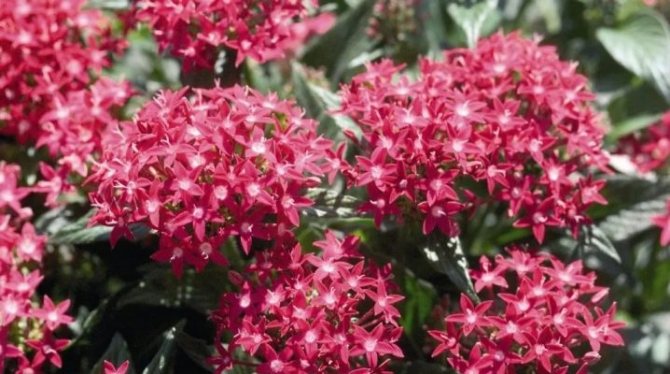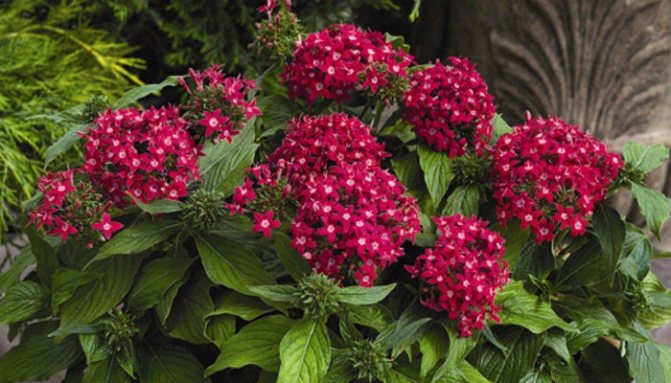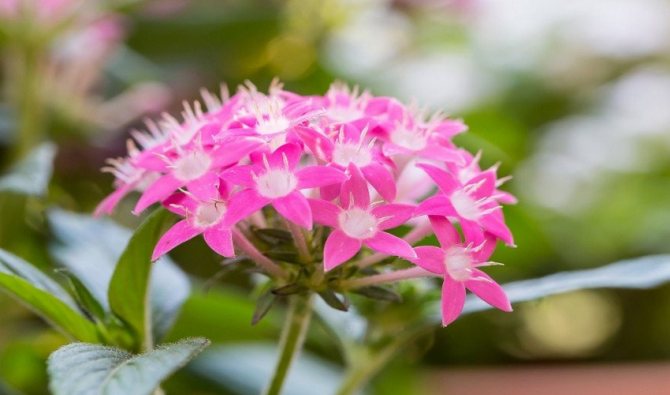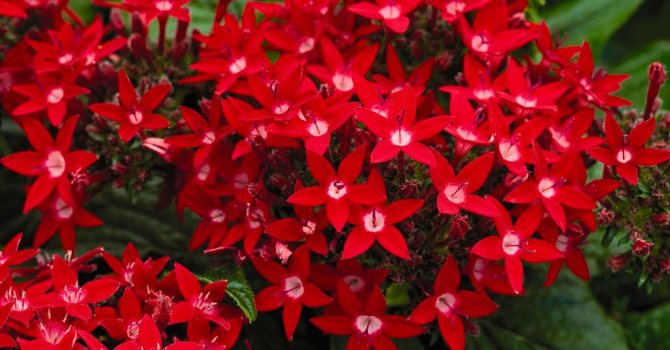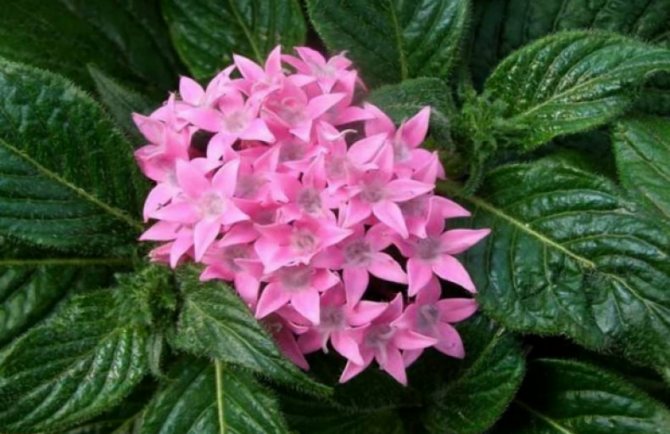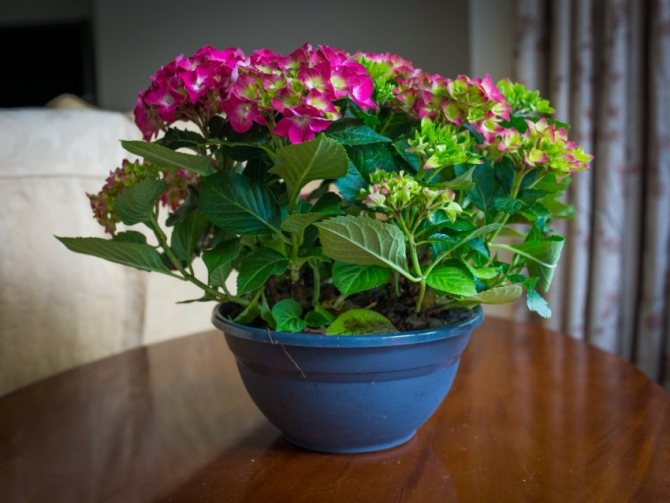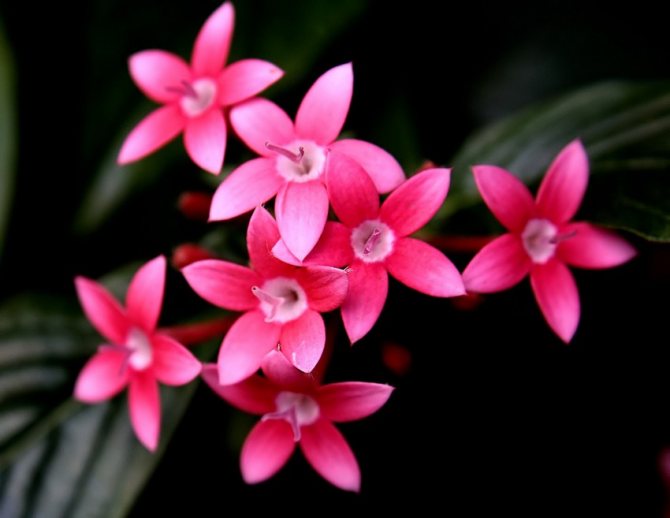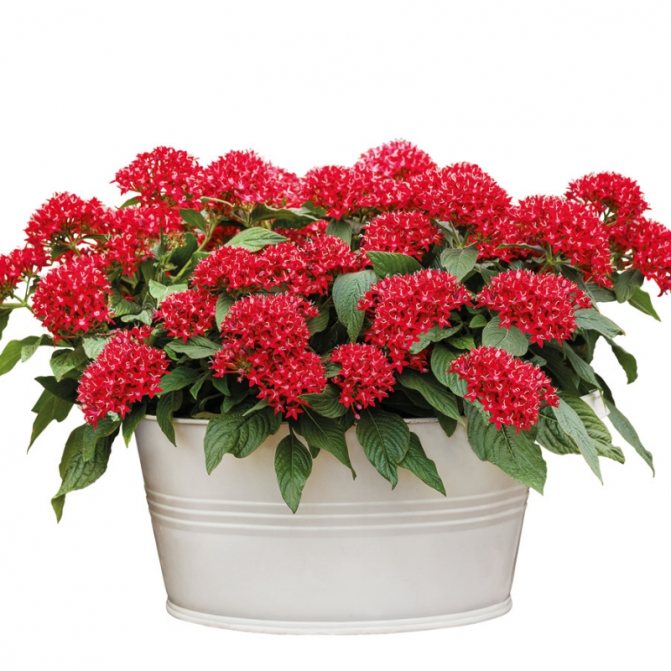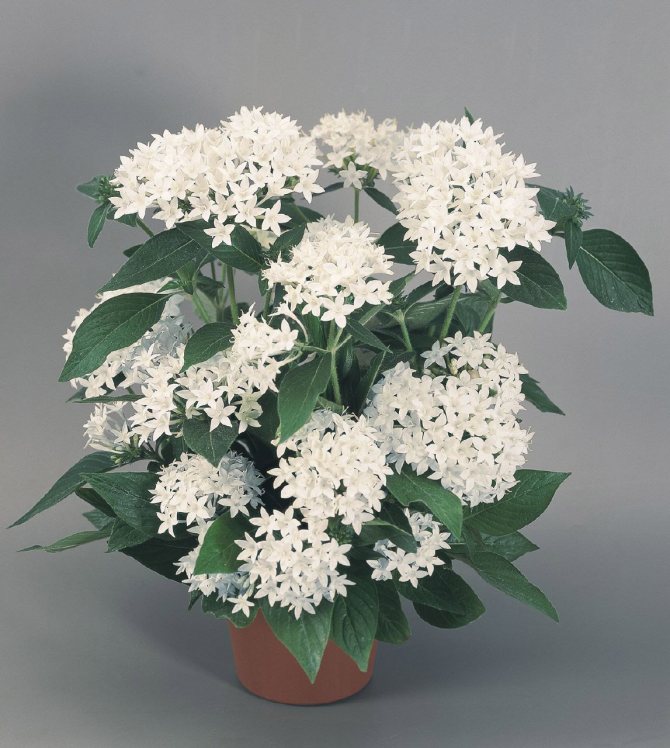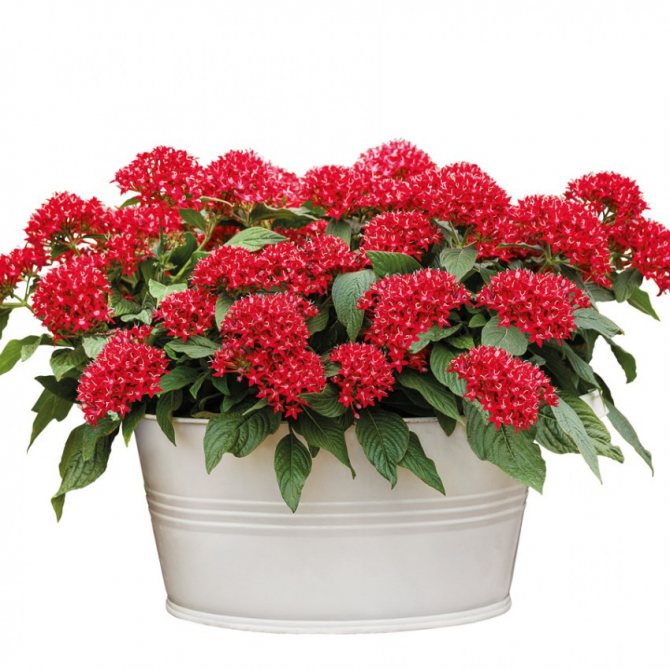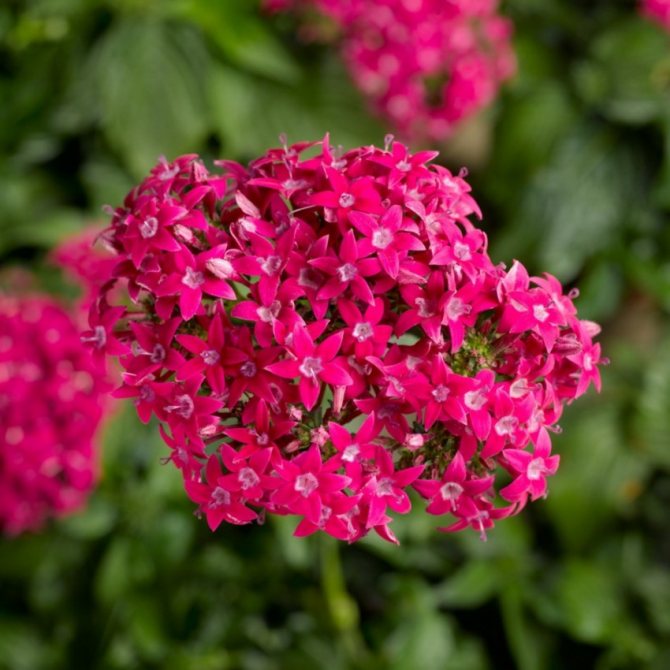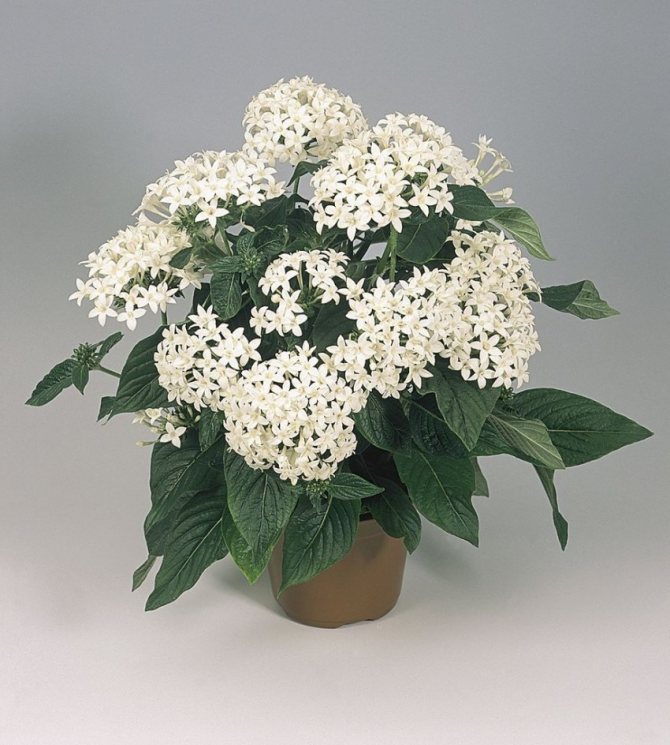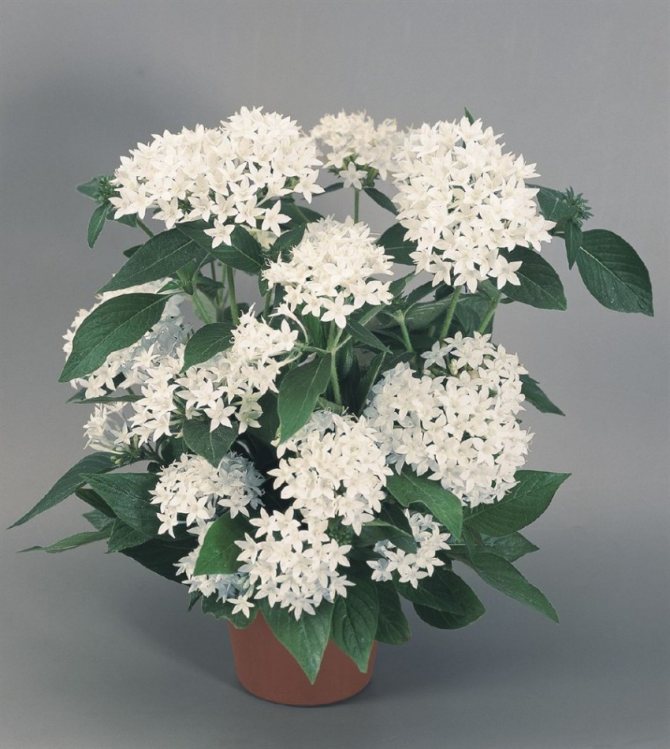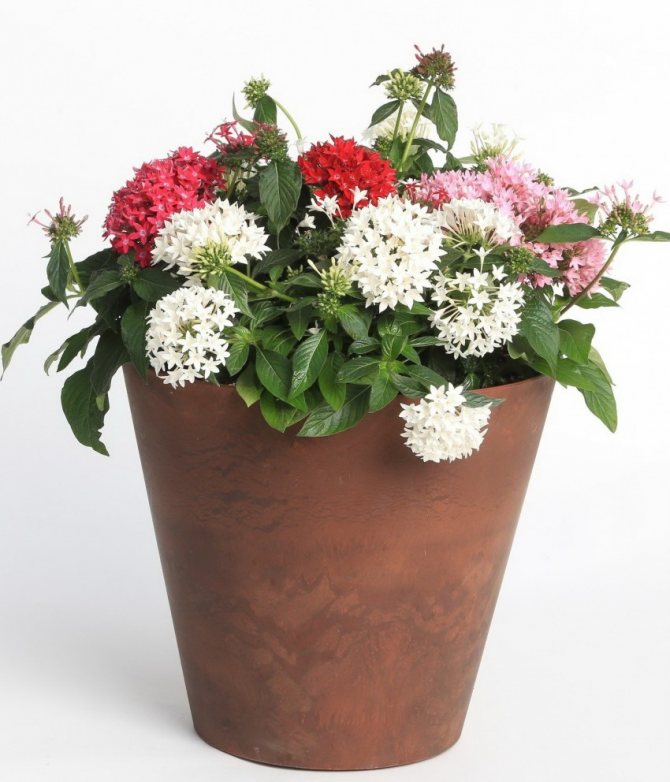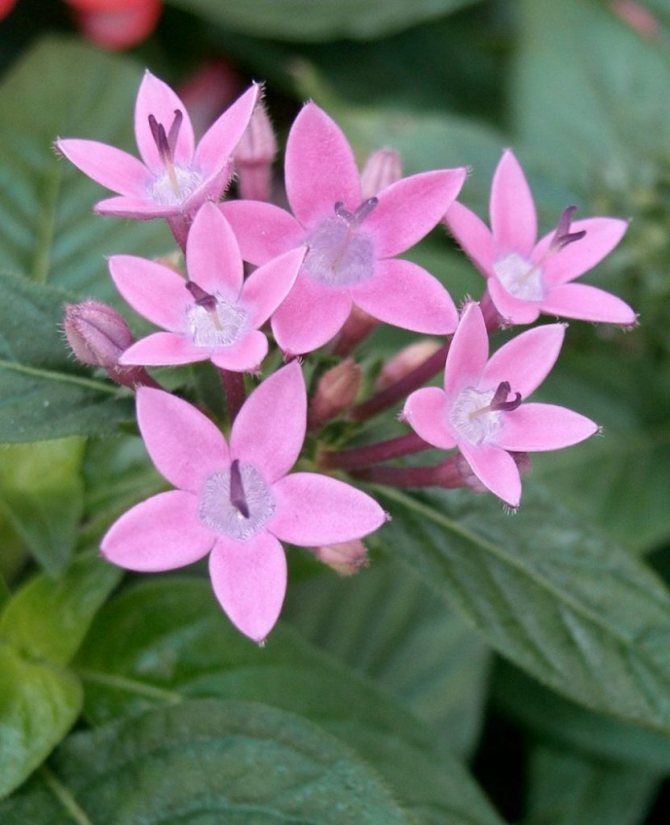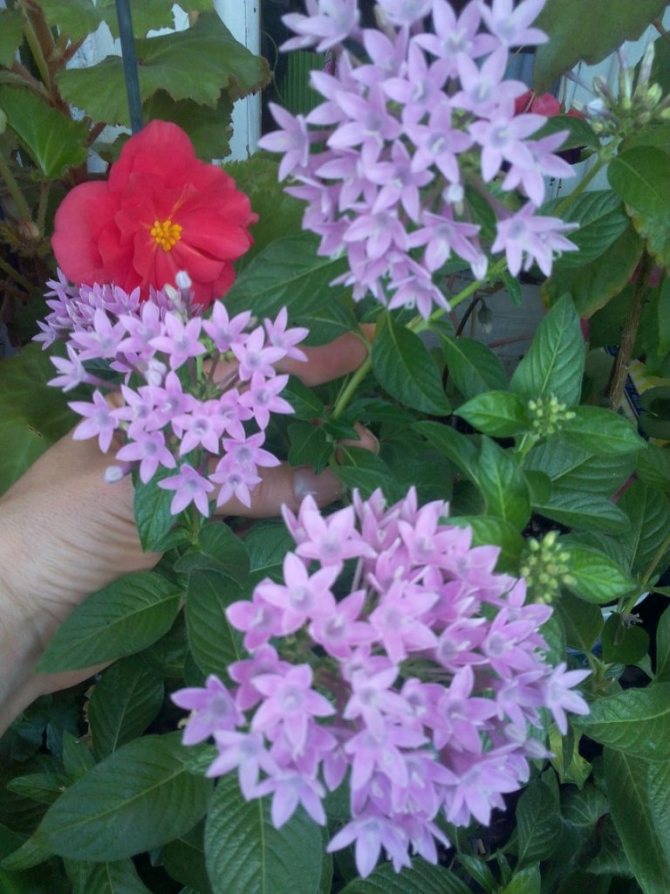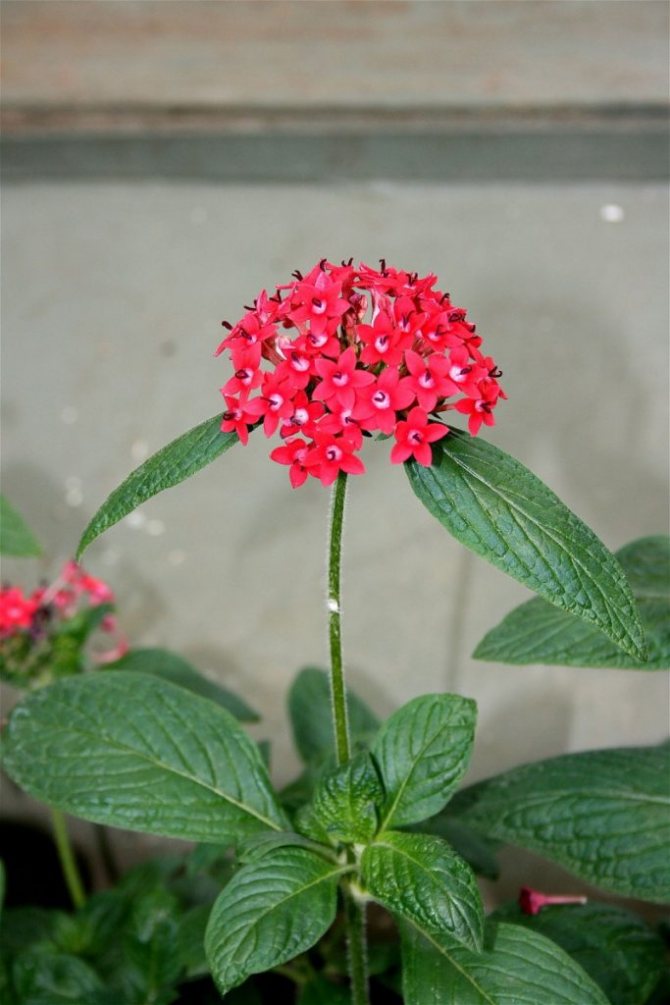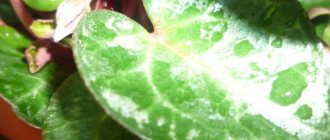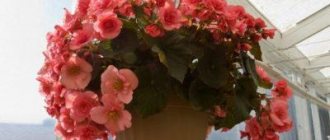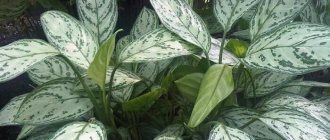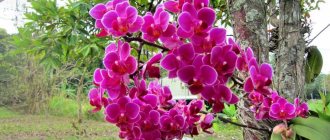At home, the lanceolate pentas is often grown, which grows up to 50 centimeters in height.
Pentas has erect shoots, elongated leaves, in the form of a lancet, up to 8 centimeters long.
Flowers at pentas are collected in inflorescences - umbrellas are of different colors - pink, purple, red, white. In diameter, flowers can reach 8-10 centimeters. The plant can bloom all year round, but the most lush flowering occurs in the winter.
Description of the shrub
At home, the pentas often reaches 50 cm in height. Its shoots are erect and weakly branching. The leaves of this plant are opposite, have a bright green color, rather wide, oval in shape.
The length of one leaf varies from 5 to 8 centimeters. Their surface is wavy, pubescent, with a pronounced central vein. Pentasa flowers are its main decoration.
They can be of a wide variety of colors, depending on the variety. Its red, pink, purple, beige or white flowers have the shape of five-pointed stars and are collected in large domed inflorescences up to 10 centimeters in diameter.

general characteristics
The plant is accustomed to tropical and subtropical climates where it produces beautiful and vibrant flowers all year round. It is not so easy to grow a plant yourself, at home it does not bloom all the time, but goes to rest for a period of cold weather. In some especially warm regions of our country, pentas is grown on the street, where it is a wonderful decoration for flower beds and front gardens.
At home, the height of the bush can reach 500 mm. Shoots are formed straight, branching is insignificant. The leaves have an oval shape, stand out with a particularly bright, saturated, green tint. The inflorescences are collected in the shape of a dome, they are formed from small flowers, very similar to a five-pointed star. Flowers can be of different colors, depending on the variety:
On window sills, you can most often find lanceolate pentas. In the warm climate of the southern region, it can grow outdoors, but only in summer.
Growing conditions
If you want to become the owner of this wonderful plant and grow it at home, you should adhere to certain recommendations.
Temperature and humidity
For normal growth at home, the pentasu is perfectly suited to an average room temperature of 20-25 ° C. In winter, it can be safely grown on the windowsill, since during this period the plant needs a slight decrease in temperature (up to 16-10 degrees), moreover, it is not afraid of drafts or sudden changes in temperature.
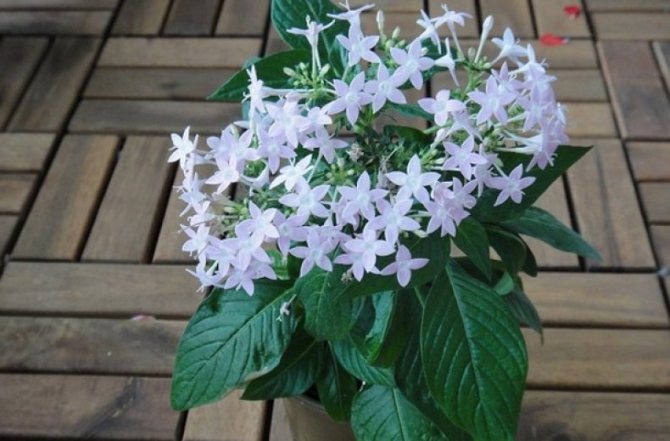

The only thing that can harm the plant is strong currents of cold wind, which can freeze the leaves, so when ventilating the room in winter, it is better to remove this flower from the window.
This plant is very fond of moisture, therefore it is necessary to ensure that its indicator in the air does not fall below 60% during the entire growth period.
This can be achieved by placing a container of water next to a flower, placing the pot in a tray with always wet expanded clay, or frequently and regularly spraying the leaves of the plant, trying not to get on the inflorescences.
Lighting
Pentas loves bright light and grows well even in direct sunlight, therefore, as his permanent "residence", he is often assigned the sill of the southern window.
However, it is worth watching the plant, and in the event that in the summer you began to observe burns on the leaves of your plant, it is still better to shade the window a little.At this time of year, the pot can be taken out into the fresh air of the balcony or terrace.


But in winter, on the contrary, if your flower is noticeably stretched out and has lost its stability, this indicates a lack of light. In this case, it will be advisable to use special phyto-lamps for plants.
The soil
When choosing a soil for a pentas, you can take a ready-made soil for flowering plants, or you can prepare an earthen mixture yourself. To do this, you need leafy and turfy soil mixed with sand, in a 2: 2: 1 ratio.
The main thing is to remember that this flower loves nutritious, fertile, loose soil, the acidity of which ranges from 5.5 to 6.5.
Recommendations for the cultivation of pentas
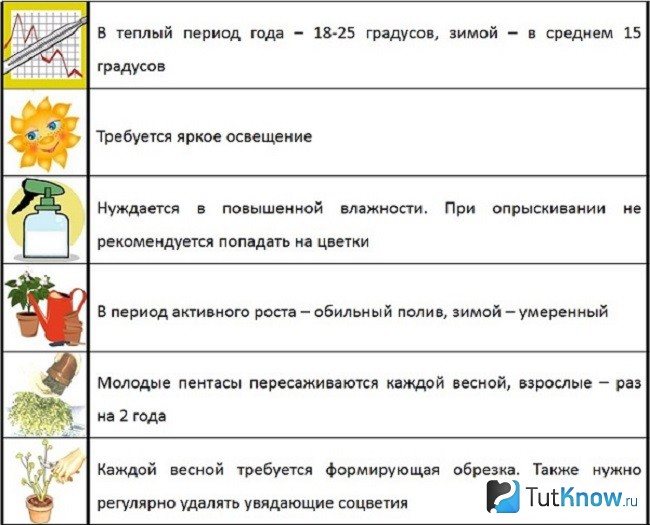

- Lighting.
Pentas is very fond of bright lighting, but only at lunchtime it should be slightly shaded with translucent curtains, gauze draperies or stick paper on glass. Therefore, a pot with a plant, you can not be afraid to place it on the windows of the southern exposure, the window sills of the south-west and south-east direction are also suitable. But it is necessary to accustom pentas to bright light gradually - this should be done immediately after purchase or after a rather long cloudy period. In the spring and summer months, it is recommended to expose the plant to fresh air, in a place with bright lighting. Pentas is completely indifferent to drafts and loves clean air, therefore, if there is no way to put a flower pot on a balcony or veranda (track), then it is necessary to regularly ventilate the room. For the autumn-spring season, the plant will have to arrange supplementary lighting with special phytolamps.
Content temperature.
With the arrival of the warm season, the pentas prefers moderate thermometer readings - 20-25 degrees, during the autumn-winter period the temperature should not fall below 10 degrees, but 16 degrees of heat are considered acceptable - the conditions for a cool wintering of the plant. If such conditions are not maintained, that is, the temperatures will be higher, then the pentas will react by drying out the leaf plates, and the shoots will be ugly naked and stretched. The same can occur at too high summer temperatures, then the shoots begin to lose their stability.
Recommended humidity.
Pentas is very sensitive to the amount of moisture in the air, its indicators should be at the level of 60%. To maintain these indicators, it is necessary to regularly spray the plant with soft water. You will have to make sure that moisture does not get on the flower petals. To increase the humidity, you can set the pot with the plant on moistened expanded clay or pebbles in a deep pan, the bottom of the pot should not touch the water. Sometimes vessels with water are placed next to the plant.
Watering.
For irrigation, it is best to use soft water, it is obtained by filtration, settling or boiling. In order for the plant to please with summer flowering, it is necessary with the arrival of spring heat to begin to abundantly moisturize the soil in the pot. The water temperature should vary between 20-23 degrees. As soon as the soil in the pot on top becomes dry, it should be moistened. When wintering time comes, watering is reduced quite strongly and is done only when a couple of days have passed since the top layer of the earth dries up. It is necessary to ensure that the ground is not too flooded with water, as this will contribute to the decay of the root system of the pentas, which is especially harmful during periods of low temperatures, this can also lead to all kinds of diseases. Watering is required carefully so that the flowers are not watered with water, from this they will turn brown and lose their beauty.
The choice of fertilizers for the pentas.
Top dressing must be chosen with a complex of minerals for flowering houseplants, those in which nitrogen predominates in the composition.Fertilization of the plant is carried out during the period of its vegetative activity (spring-summer) with a half-month regularity. During winter dormancy, fertilizers are not applied to the soil.
Trimming the pentas.
The plant tends to stretch its shoots ugly with age, so it is best to cut them off regularly so that they do not exceed 40 cm in length from the base. The shape of the bush will be more fluffy if the tops of the stems are pinched in the spring - this must be done before the buds of the plant become noticeable. The pruning procedure must be carried out during those periods when the plant has ceased to bloom. But, and this cannot guarantee the preservation of the decorative effect of the bush, therefore, experienced growers recommend simply updating the pentas by growing it again.
Read also: Dewdrop - a predator of the plant world, Indoor plants - photo and video
- Soil and replanting tips.
The growth of the pentas is quite fast, therefore, for young plants, the pot and substrate are changed annually, and for adults this procedure is performed every two years. When choosing a pot, they try to choose a new container with a larger diameter. But as soon as an adult plant is transplanted into a pot with a diameter of 20 cm, then later it is recommended to simply change the topsoil, without transplanting. Some growers use old pots when transplanting, in this case, you will have to cut a little roots from the bush. In the bottom of the pot, it is necessary to make holes for the drain of excess water and pour fine expanded clay (pebbles) or finely crushed brick into it.
Pentas is very sensitive to the composition of the soil, it can hardly tolerate the presence of a variety of salts that may be in the substrate. The soil is chosen sufficiently nutritious, light and loose so that water and air can easily pass through it. You can use purchased land for ornamental and flowering indoor plants, it is important that the soil is acidic, pH 5.5–6.5. The soil mixture can be independently compiled based on the following components:
leafy land, sod land, river coarse sand (proportions 2: 2: 1, respectively);
How to propagate pentas: landing rules
There are two popular ways to propagate this flower: by seed and cuttings.
Seeds
This method is good because it is suitable for any time of the year. It is light enough, and in order to propagate pentas in this way, you need to purchase flower seeds from any specialty store, sow them on moist soil without digging in, and leave them in a sunny place so that light, heat and moisture generously stimulate the seeds to germinate. ...


If you keep the air temperature around 25 degrees, and the humidity is at least 60%, in 2-3 weeks you will receive the first shoots of your future dwarf shrubs.
Stem cuttings
To propagate pentasa in this way, you can use cuttings that you have left after rejuvenating or pruning your plant, or cut new ones.
The main thing is that the cut stems should be at least 5-8 cm long. The minimum temperature for this kind of reproduction should be 16-18 degrees.
Cuttings can be previously held in water for several hours or planted in prepared, moist soil immediately. Rooting should take place in 8-10 days. After the roots of the plant occupy the entire pot, it is transplanted.
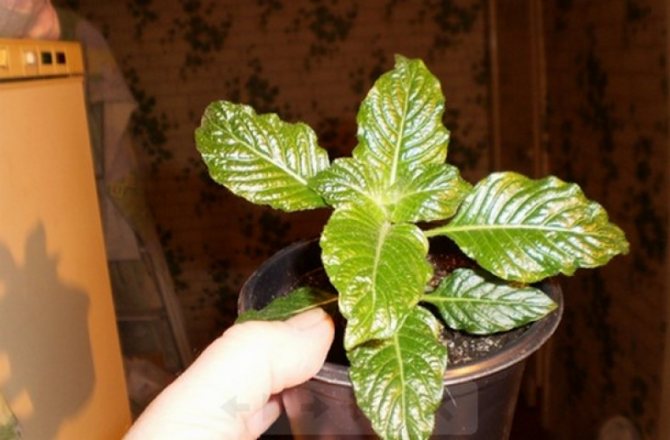

How to choose the right soil?
If you choose the wrong soil for germinating seeds, you may not get the desired result. Store-bought potting soil mixes, which are already collected in the required proportions, are ideal for pentas. If you want to start preparing the nutrient medium yourself, then when using containers, it is better to make soil from peat moss, deciduous mixture and perlite.All components are connected in the same proportion.
It is such soil that remains moist for a long time, but at the same time does not retain water in large quantities. Pentas loves fertile, well-drained light soil that is slightly acidic.


At the stage of caring for seedlings, it is important to take into account not only the temperature regime, but also the amount of light and moisture. Pentas grows well and blooms profusely in the sun. Seedlings should receive 6 or more light hours per day, not necessarily sequentially. In hot climates, bright sun with a little afternoon shade is ideal.
Home care
Pentas does not require special time-consuming care measures for normal growth and flowering at home. Everything you need to do comes down to a standard set of procedures.
Watering
This shrub loves watering and needs it regularly, especially during the period of active growth and in the summer. To do this, it is worth using settled water at room temperature, without chlorine.
Watering is worth every time you notice that the topsoil has begun to dry out. The main thing is to remember that it is dangerous to fill the flower, because the stagnation of water in the pot provokes rotting of the root system of the flower. In winter and during the period when the flower does not bloom, watering is minimized.
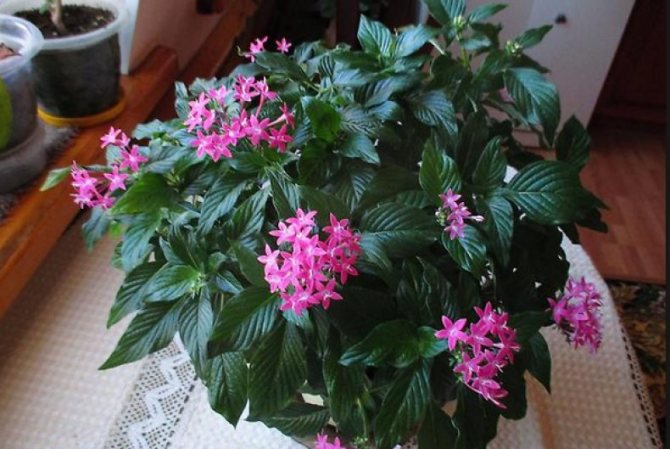

Top dressing
If you want to extend the flowering period of your pentasa, you can add a complex mineral composition for flowering plants to the water for irrigation, such as "Blank sheet" or "Master".
This will enrich the soil with phosphorus and provoke the formation of new buds. In winter, the plant does not need additional feeding.
Pruning
Since this shrub grows rapidly and reacts to various negative factors by lengthening the shoots, it regularly needs pruning to maintain its shape and splendor.
The stems should be kept up to 50 centimeters high, and the tops should be pinched to preserve the splendor of the plant. However, it is worth remembering that pruning and pinching can only be carried out during periods of rest, that is, when the shrub is not blooming.
Transfer
This flower grows quickly, so a young plant needs a regular transplant once a year, for an adult, an interval of two years is suitable. Usually this operation is carried out in the spring.
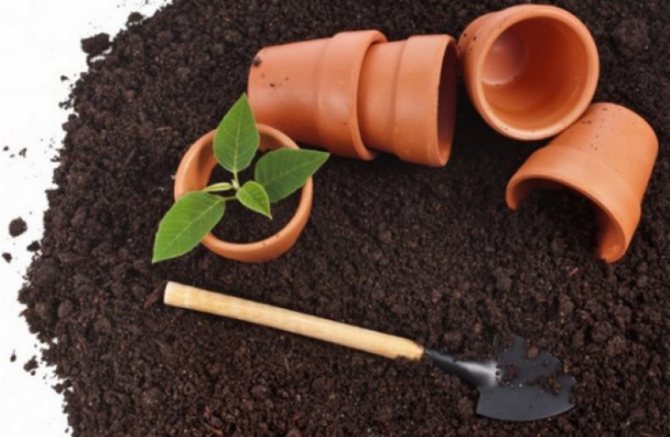

Each time you transplant, you should take a pot with a diameter slightly larger than the previous one, giving the roots of the plant more room for growth. After the plant takes up a pot with a diameter of 20 cm, it is recommended only to change the topsoil.
How to plant and replant
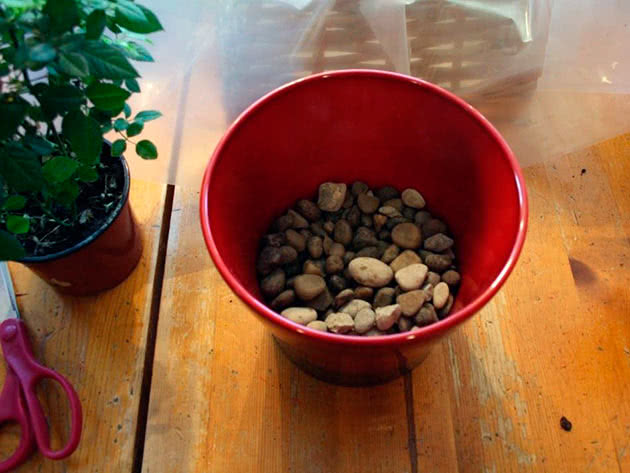

Expanded clay is ideal for creating drainage.
These two processes do not differ in requirements. You need to transplant a flower every year, but if the plant is already elderly, then you can do it 2 times less often. The following conditions must be observed:
- It is best to use a ready-made substrate as a soil for planting. It is necessary to ensure that there are no salts in the composition - the plant does not like this.
- If you want to prepare the soil yourself, then you need to mix the leaf and turf soil with sand (proportion 2: 2: 1).
- The pot should be round. Diameter - from 12 to 15 cm. When transplanting, there is no need to increase the size of the container - the flower loves moderate constraint.
- There should be a dense drainage layer at the bottom of the pot, since the Egyptian star does not tolerate stagnant water in the soil and soil acidification.
- A tray with a layer of moss is often installed under the pot. This allows you to maintain high humidity in the flowerpot. The moss should not touch the bottom of the pot.
Step-by-step instructions for transplanting
The transplant takes place according to the following algorithm:
- Take a pot of the same size as the previous one. The Egyptian star does not tolerate changes, but she loves when her roots are a little cramped. Differences of 2 cm are acceptable, but no more.
- Prepare the drainage layer and soil. The composition must be the same as at the current landing site.
- The flower is carefully dug up, shaken off large clods of soil and immediately placed in a new pot. You do not need to use any solutions. The roots should not be washed either - the plant does not like moisture stagnation.
- After transplanting, the flower is rearranged for 2-3 days in a place where there is no direct sunlight.
- The leaves are sprayed daily with water, but only before the plant is returned to the window.
The flower adheres perfectly to the stem. By default, it does not need support. But with a lack of sun, the stem weakens over time, and then it may be needed. There are no special requirements for support - a regular stick with a garter is perfect.
Plant diseases and pests
Chlorosis of the leaves is the disease that most commonly affects the pentas. To combat it in the early stages, at the first detection of leaf damage, that is, if the leaves began to turn yellow for no reason, it is worth fertilizing the soil with preparations that increase the amount of chlorophyll in the greenery of plants, so-called chelated fertilizers, such as Hydro Vera or Hydro Flor ".
Of the pests, the biggest lovers of domestic plants are the scale insect or spider mite.
To combat them, you can use chemicals such as "Fitoverm" or "Actellik" or treat the leaves of the plant with folk remedies, such as medical alcohol, a solution of laundry soap or infusion of garlic or onions.


It is enough to wipe the leaves with a solution and rinse with warm water. The procedure can be repeated if necessary.
That's all you need to know about growing a beautiful, healthy, lush pentasa flower that will delight you for a long time with its exuberant, vibrant flowering.
Botanical name: Pentas.
Flower pentas - family ... Madder.
Origin ... East Africa.
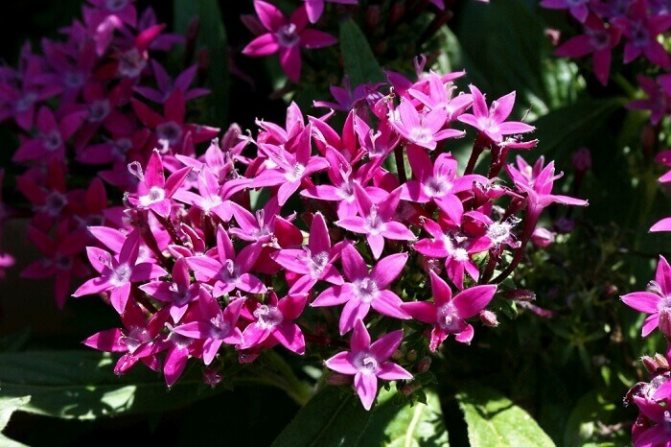

Description ... The genus Pentas consists of about 40 species of biennial or perennial evergreen shrubs. Stems erect, branching, woody with age. Leaves dark green, lanceolate or lanceolate, 8-10 cm long, arranged oppositely or in a spiral, glossy leaf blades. Young shoots and leaves are covered with fluff. Flowers collected in large umbrellas up to 10 cm in diameter, which appear on the tops of the shoots and often completely hide the foliage. The flowers are small, star-shaped, with pointed petals, very attractive, white, pink, lilac, salmon or red. Variegated varieties have attractive green leaves with a white or light green border along the edge of the leaf plate.


Height ... Plant pentas developing rapidly and in a season can reach a height 30 - 40 cm.
Possible difficulties of growing
Diseases
- Pentas can stretch and lose stability with insufficient light
- The plant may slow down in growth with a high salt content in the soil.
- Leaves may turn yellow when the soil is dry and with a lack of nitrogen and iron in fertilizers.
Pests
The pentas may be damaged ticks or aphids.
With minor damage, you can:
- to treat the whole plant with chemicals,
- water the roots of the plant with fertilizer,
- process the leaves and stems of the plant using folk methods - a solution of laundry soap, medical alcohol or tinctures of onion and garlic.


In case of significant damage, the plant must be destroyed!
However, shoots that are not damaged by pests can form the basis for cuttings from which new plant specimens will grow.
These are all the subtleties of growing pentas in indoor conditions. Isn't it difficult? Adhering to simple rules and tips, you will receive a lush and beautiful flower on your windowsill that will delight you with its flowering for several months.
1.Pentas - planting and leaving
1.1. Reproduction, growing from seeds
Multiply cuttings 5 - 8 cm long.taken in the spring when pruning the plant. Place the lower end of the cuttings in rooting powder and immerse in wet peat mixed with sand. Cover up the seed pots transparent plastic cover or glass and place in a warm place with temperature 21 - 27 ° C. Rooting is pretty easy within 4 - 6 weeks... Often, pentas cuttings take root even in an ordinary glass of water within a couple of weeks.
Seeds can be sown in spring, from sowing seeds to the onset of flowering takes about 4 - 6 months... Sowing is carried out on the surface of the substrate, for seed germination need light... The first shoots appear within a week at a temperature 20 - 25 ° C ... Fresh seeds have the highest germination, there is no point in sowing old ones.


1.2 Diseases and pests of indoor pentas
On the leaves appear sunburn when hit by direct rays. With waterlogging, especially in the cold season the plant can rot... With a lack of light flowering will not be so abundant or not at all, and the plant will become loose and elongated... When kept in a warm and dry atmosphere on the plant will be dry young leaves... Sometimes the pentas develops chlorosis - feed the bush with iron chelate.
Of pests the appearance of red spiderwebs, aphids and whiteflies is possible.
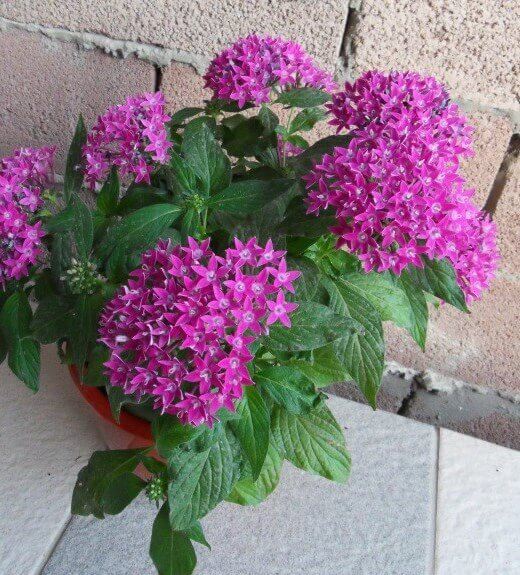

1.3 Soil
Requires loose, nutritious, well-drained soil with acidic pH about 5.5 - 6... A mixture of garden soil with peat or leaf humus, with the addition of a small amount of charcoal and river sand, is suitable.
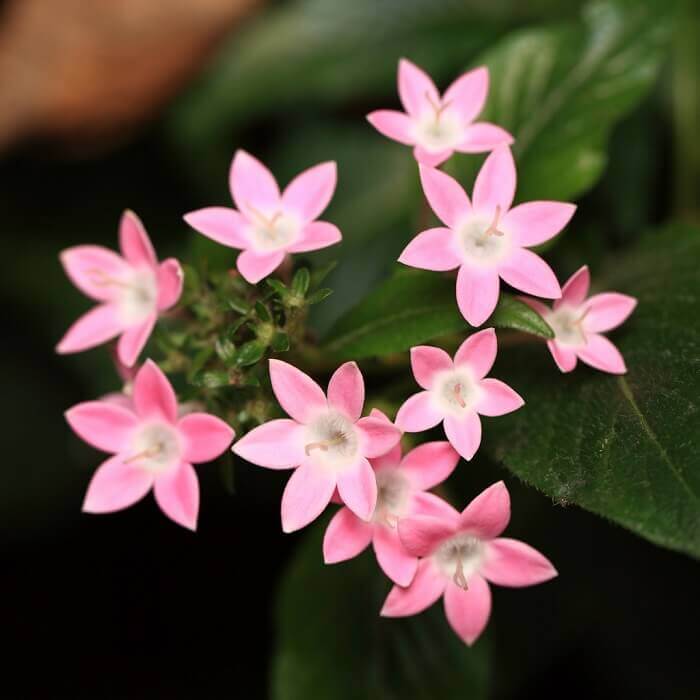

1.4 Home care
Prune the plant after flowering to maintain a neat and compact shape. Timely remove wilting inflorescences to extend the flowering period. Pinch regularly tips of young shoots for better branching. Pentas can take out into the street in the warm season, placing in partial shade.


1.5 Flowering time
In culture, flowers appear from May to October, the flowering period is long. Each inflorescence - an umbrella remains attractive within 3 weeks... With proper care, re-bloom during a year.
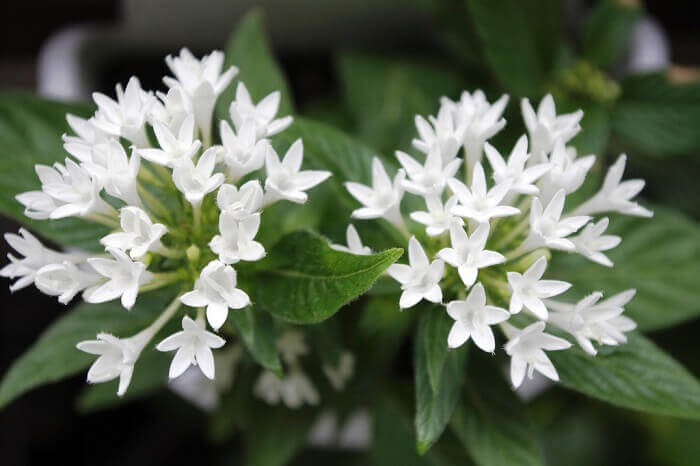

1.6 Temperature
During the growing season, they are kept at a temperature about 18 ° C, at a higher temperature, the plant fades faster... In the winter months comes dormant periodwhich the plant must hold at a temperature of about 13 ° C... Do not expose the plant to temperatures below 10 ° C - it slows down or stops growth.


1.7 Lighting
Needed direct sunlight access morning and evening for about 3 hours a day... Organize shading on summer days. Can grow in partial shade, but flowering in such conditions will less abundant... If there is a lack of natural light, you can illuminate with fluorescent lampsand. Pentas refers to plants long daylight hours and for the onset of flowering, light is simply necessary for him. For growing a beautiful, symmetrical plant turn the pot around the axis a quarter turn every week when watering to keep the stems from reaching for the light source.
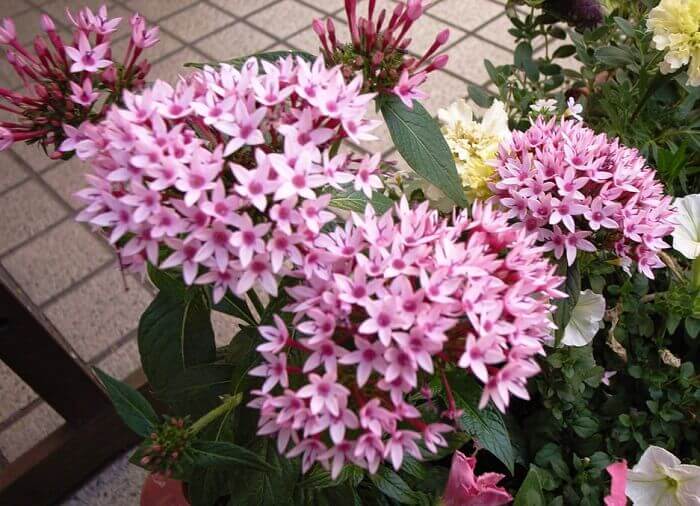

1.8 Top dressing
During the growing season in spring and summer fed 2 times a month complex fertilizers. In the autumn and winter periods, feeding is stopped.
1.9. Watering
During the growing season water regularly... Let the topsoil be about 1 cm... dry out between waterings. During winter rest, simply protect the earth ball from completely drying out. Watering cut after flowering - after 1 - 1.5 months, and then resume with the beginning of new growth, in the spring. Plant does not like cold water - use for irrigation only settled water at room temperature.
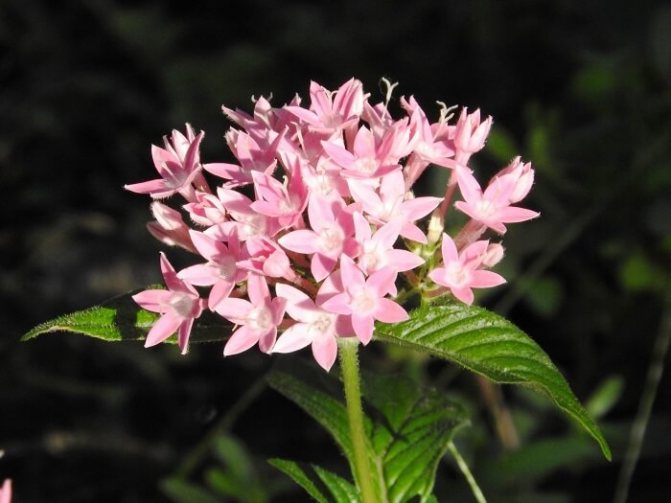

1.10 Transfer
Pentas loves some cramped conditionsso don't change the size of the pot every year.When grown in a cramped pot, flowering will be more abundant. Transplant adult pentas in March, every 2 years.


1.11 Spraying
If the indoor air becomes too dry or the temperature of the content exceeds 22 ° С, can spray the leaves with water at room temperature in the morning hours. Using humidifier also helps to raise humidity levels. Do not expose the plant to cold drafts.
How to care for a flower
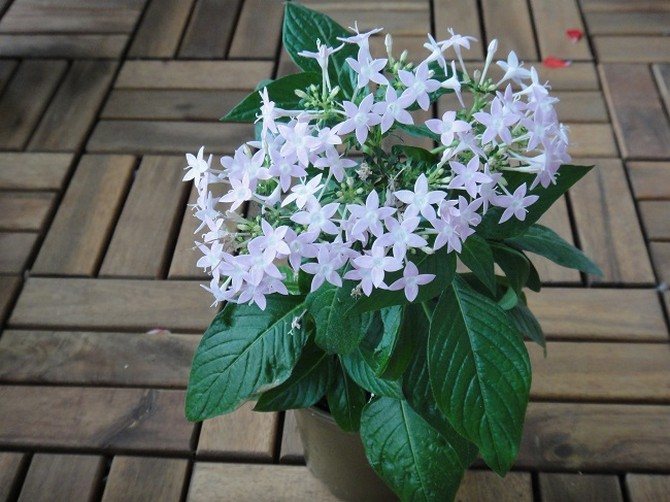

Caring for an Egyptian star is easy
In matters of watering and feeding, the Egyptian star can be called an unpretentious plant. But you should still be aware of some features.
Watering and feeding depending on the season
Flowers must be watered according to 3 rules:
- If you want the plant to bloom in the warm season, then from the beginning of spring to the end of summer it needs to be watered quite often. You should not wait for the soil to dry completely.
- In autumn and winter, regardless of the flowering period, it is necessary to water only after the soil gets rid of moisture. But too rarely, this should also not be done, as the leaves may turn yellow.
- Regardless of watering, you need to spray the foliage every few days, but do not allow water to get on the inflorescences.
The plant is fed with mineral compositions with a high phosphorus content. There are no special requirements - the complex that is in any flower shop is enough.
How to achieve flowering
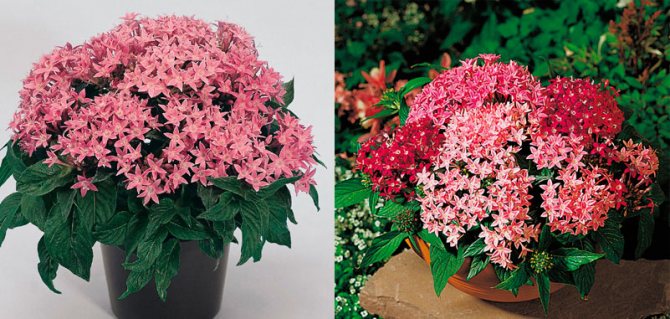

Many growers pinch the stems before the dormant period, but this is not a prerequisite.
Fall-winter is the standard flowering period. But if watering is intensified in the spring, then the second stage will begin by summer. It is the frequent irrigation of the land that is the main condition in order to make the plant bloom in the hot season. Faded buds must be cut off.
How to care during a rest period
After the bush has faded, it must be moved to a cool place. In a private house, it can be a cellar or a basement, in an apartment - just a dark corner. After a month and a half, the plant is again placed on the window - first to the north, later to the south, thereby preparing for a new period of active growth.
Plant formation


You can pinch an Egyptian star only during those periods when it is not blooming.
The Egyptian star is quite picky in terms of development, it often tends to grow somewhere to the side. Therefore, they pinch unnecessary shoots. For a neat look, the flower is also cut from the top. The optimal tool is ordinary household scissors. The maximum plant height is 50 cm, but if it is higher, it will begin to "fall apart" and lose its bushy shape.
Common care mistakes
Common mistakes in caring for an Egyptian star and how to solve them:
- Insufficient watering. If you water the flower too rarely, the leaves will turn yellow and begin to wilt. It is quite simple to fix the problem: water more often and install a pallet with moss or expanded clay.
- Bad soil. If ordinary soil is used instead of a substrate, then the plant may begin to wither and dry out. The solution to the problem is obvious - just transplant it into a more suitable soil and water more often.
- There is too much sun. Even a thermophilic plant like the pentas can be damaged in the summer. Typical burns appear on the leaves. At the first sign of this problem, the flower must be immediately removed from the window, and kept out of direct sunlight. Severely damaged leaves can be removed, but not all at once.
2. Varieties:
2.1.Pentas lanceolate - Pentas lanceolata
A flowering plant, a perennial shrub that can reach a height of 180 cm, has green oval or spear-shaped leaves. Well pronounced leaf veins are slightly recessed into leaf plates. The surface of the leaf blades is covered with sparse pubescence.The flowers are usually pink, red, or white, but modern varieties have tones of purple and lavender. There are specimens with flowers painted in two tones at once - for example, pink with a red center. It grows slowly.
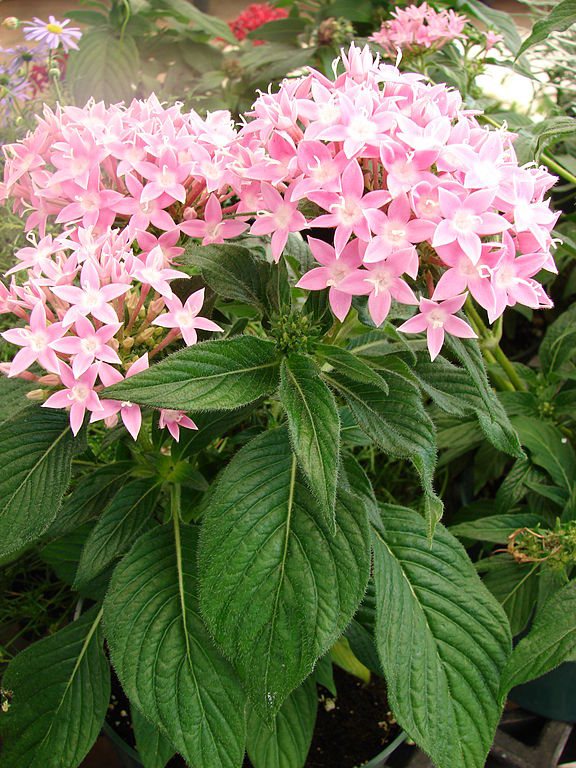

You may also be interested in:
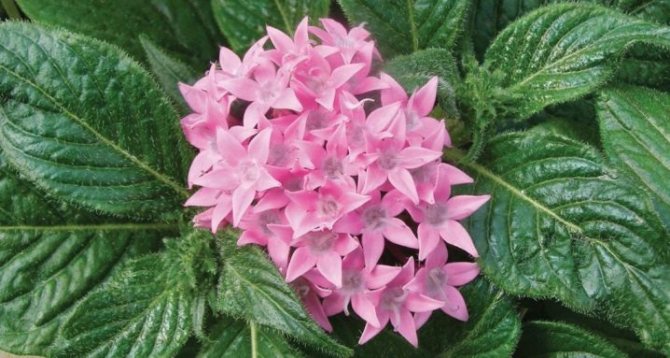

Pentas or Egyptian star is an extremely beautiful bushy flower of small size. It grows wild in Africa and Madagascar, but it can be grown indoors if desired. How to do this correctly, which varieties are better to choose, we will talk in this article.
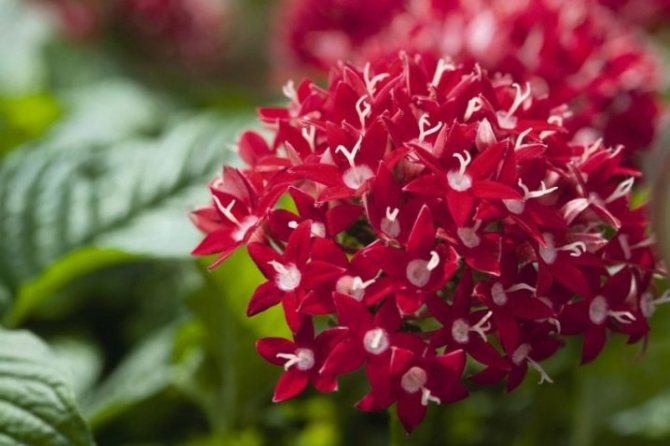

Growing a pentas flower from seed
My first acquaintance with the pentas plant happened several years ago. Received the seeds in the mail in the month of February. He did not hesitate and immediately sowed seeds in purchased universal soil. Before sowing, the soil was moistened with a spray bottle and spread over the seeds.
He did not sprinkle anything, but covered it with a bag and put it on the south-facing windowsill, where the temperature was kept about twenty degrees. Seed shoots were not friendly, only a couple of five seeds emerged. They grew slowly. After the first real leaf appeared, I cut the seedlings into one-hundred-gram plastic cups.
In April, the pentases became more cheerful, after which they actively started to grow. I pinched young plants a couple of times for greater bushiness. It should be noted that the pentas flower is very photophilous and in indoor conditions suffers greatly from a lack of sunlight, therefore, at the first opportunity, he took the plants to a warm and sheltered place from the winds.
In the month of June, they delighted me with their first buds. The flowers of the pentas are collected in umbrella-shaped inflorescences and are of various colors: pink, red, purple, and also white. I had - with red flowers. The pentases bloomed well until the end of the summer period, but they did not survive the winter period - they flooded.
Features of the
This indoor flower is one of the few that pleases the eye of its owner with a beautiful and abundant flowering in the cold season. This amazing plant blooms profusely, long, bright and colorful, which is why it is often called not only the star of Egypt, but also a bouquet in a pot. The morphological description of a flower is as follows:
- family Madder - evergreen herbaceous or semi-shrub plant;
- in natural conditions, the flowering period can reach 11 months;
- stems are erect, even, their maximum height is up to 50 cm in artificial cultivation; the color of the stems is dark green; branching of lateral shoots is practically absent;
- leaves are oval, thin, smooth, wide; their color is dark green, and the size can reach 6 cm;
- flowers are small, five-pointed, collected in dome-shaped inflorescences; their color can be white, pink, lilac, red or purple.


In indoor conditions or winter greenhouses, only lanceolate pentas are grown. In open ground, it can be planted only at temperatures not lower than +7 degrees.
Therefore, in our country, it is usually grown indoors in pots in winter, and in summer it is transplanted to a garden plot or simply carried out vases with an Egyptian star outside.
In addition to the lanceolate pentas, there are also types such as:
- long-flowered - has small elongated flowers that are collected in rare inflorescences;
- Bussei - these are lush inflorescences, the color of the peduncles themselves is pink with an orange frame; the border of each flower is strongly curved outward.


However, these two species are only suitable for outdoor cultivation. Therefore, they can be planted only in regions where the average annual air temperature does not drop below +10 degrees.
Main types
Pentas is a plant from the Madder family, which includes 50 species. The flower is most widespread in Madagascar and tropical regions of Africa.
Despite the fairly large variety, the following varieties are considered the most popular:
- lanceolate - differs in large inflorescences, which reach a diameter of 10 cm. The stem is straight, and woody in the lower part;
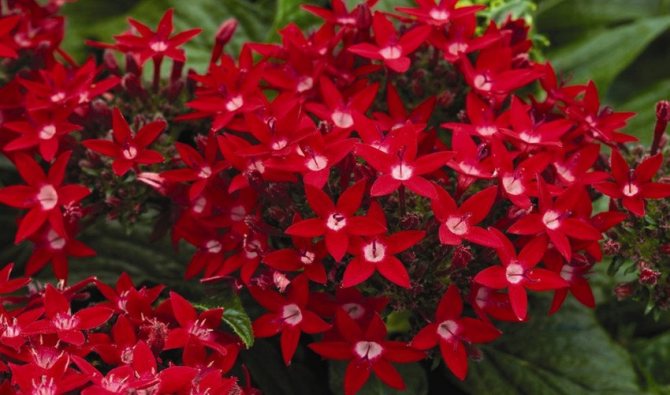

- long-flowered - the flowers are long, shaped like tubes, painted only white. Each bud is deflected to the side;
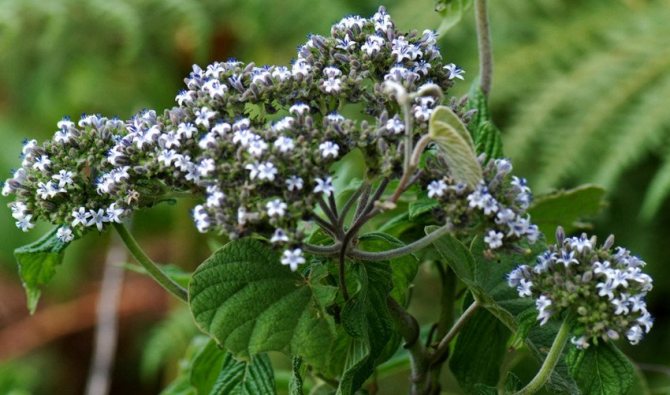

- pentas Bussei - the buds are colored pink with an orange tint. The flowering is dense, in summer almost the entire bush is covered with flowers.


Varieties
Pentas lanceolate has several different varieties, each of which has its own unique characteristics.
- "Starla White" - powerful and beautiful plants. Their maximum height is 45 cm. They have dense inflorescences, in which snow-white five-pointed flowers are collected. They are located on tall stems just above the leaves. This type of pentasa is ideal for growing in a room, a greenhouse, on a terrace or a glazed loggia.


- "New Look F1" - a hybrid with abundant flowering. The flower is compact in size, and its height does not exceed 25 cm. The bush is quite strong, but at the same time harmoniously branched - all the shoots are erect, due to which the pentas itself looks lush and voluminous. The color of the flowers can be white, pink, lilac or red. This variety is ideal for indoor cultivation, but it can also be displayed outdoors in containers during hot seasons.
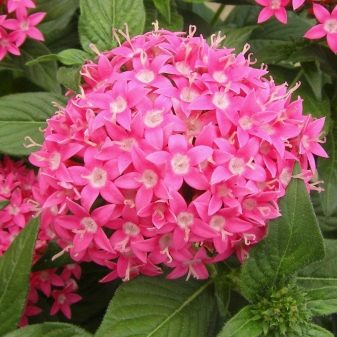

- "Starla mix" - lanceolate pentas with stems up to 45 cm high. Such a bush is grown in a room, on a loggia or in a greenhouse. He loves abundant watering and high humidity combined with temperatures above +20 degrees. The color of the flowers is lilac, lilac, white and pink. Leaves are wide, oval, dark green in color. The duration of continuous flowering is over 6 months.


- Starla Lavender Shades - This is a powerful plant, the height of which, with proper care, reaches 50 cm. The leaves are powerful, dense, located above large inflorescences, the diameter of which can reach 13 cm. The color of the flowers is light purple. This variety is suitable for both indoor and outdoor cultivation. In the latter case, for wintering, the plant is either covered or transplanted into containers.


- "Graffiti" - This is an annual plant, the height of which does not exceed 35 cm. The type of branching is basal. The inflorescences are located high above the leaves, the color of the flowers themselves is lilac, purple, white or red. These plants are grown in rooms, flowerpots on balconies or loggias, as well as outdoors when the weather conditions are right.
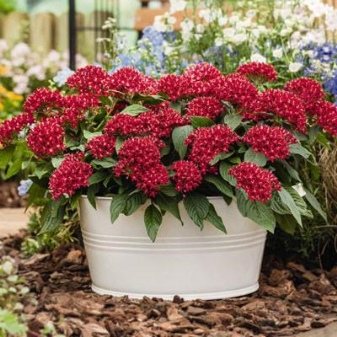

- Starla Deep Rose - it is a bushy and powerfully developed plant, the height of which reaches 45 cm. The flowers are small with pointed edges, their color is deep pink. They are collected in powerful inflorescences up to 12 cm in diameter. This variety is suitable for growing as a balcony, pot or flower bed plant.


Such an abundance of various varieties of Egyptian roses allows you to choose the best option for decorating and improving both the indoor flower garden and the personal plot, depending on the goals and desires.
Features of growing lanceolate pentas
If you do not yet have experience in growing lanceolate pentas, you may encounter the following features of the plant and problems in its maintenance:
- from October to February, it is advisable for the pentasu to be at rest: the pot with the plant is placed on a lighted window in a cool room and watering is gradually reduced: if the moisture is left at the same level, the leaves of the plant will begin to turn yellow, and the roots will rot. Pentas normally tolerates drafts, so airing will not harm it;
- at the beginning of spring, when active growth begins at the pentas, it is necessary to cut off its shoots by a third of the length, because in a year they managed to grow strongly. Try not to allow the stems to grow longer than 45 cm;
- during the growing season, pinch the ends of the shoots so that the bush becomes lush;
- to extend the flowering of the pentas until the end of September, remove the first buds;
- from a lack of moisture, nitrogen or iron in the substrate, the leaves of the pentas begin to turn yellow;
- from a lack of light, the shoots of the pentas are strongly stretched;
- pentas lanceolate can be affected by spider mites, aphids and whiteflies, but if you create the necessary conditions for the plant and take good care of it, pests will not settle on it.
Care rules
In order for a flower to really grow as the manufacturer promises, it must be properly and comprehensively looked after at home.
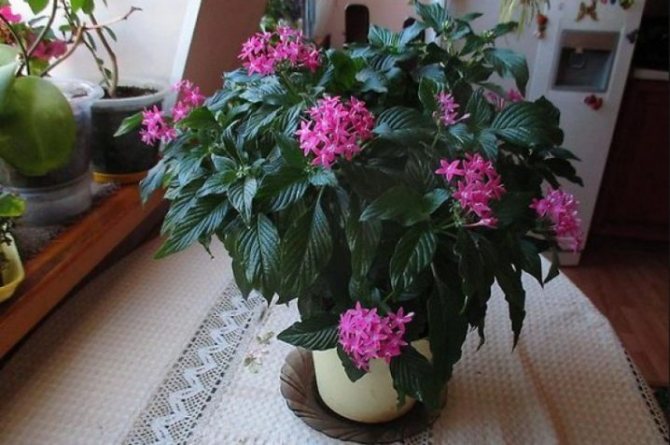

Watering
Pentas is a plant that is extremely demanding for watering. It should be regular and fairly abundant. But here you should pay attention to the fact that there is no excess moisture - otherwise the root system of the Egyptian star will begin to rot, and it itself will disappear. Therefore, experienced flower growers are advised to irrigate when the topsoil dries up by half a centimeter. Do not use ordinary tap water for irrigation. It should be soft, peeled or settled. Plants should not be irrigated with cold water - only the one that has room temperature. In winter, watering, its frequency and volume are reduced.
What the pentas is sick with
The most common flower diseases:
- Chlorosis of the leaves is the only disease of the species. The main symptom is yellowed leaves. You can fix the problem with fertilizers that promote the production of chlorophyll. They are bought at any flower shop.
- Curled leaves are a characteristic sign of aphids. You can get rid of it with the help of special chemical compounds, as well as folk remedies. The latter include a solution of laundry soap in water, ethyl alcohol or onion infusion. With these means, it is necessary to process the leaves. Severely damaged foliage should be removed.
- The appearance of a cobweb on the back of the leaves means mite infestation. Fighting them is the same as fighting aphids.
To prevent diseases, it is enough to regularly feed the flower and follow the basic rules of caring for it. The correct composition of the soil is also very important - without salts, with moderate acidity and a good drainage layer.
Reproduction
Cuttings
This is a convenient, fairly fast and simple option. Here you can use those shoots that were obtained during pruning or pinching the pentas. The sequence of actions will be as follows:
- young stems are kept in a solution of a rooting stimulator for 45 minutes;
- drainage and soil are poured into a container with a capacity of 200-300 ml, the finished substrate is watered;
- prepared cuttings up to 8 cm high are planted in a prepared container and sprinkled with earth on top;
- for 10 days they are removed in a cool place with good lighting; during this time, the seedling must take root;
- after another month, the pentasa seedling can be transplanted to a permanent place; at this time, the temperature should be about 17 degrees above zero, the humidity should be about 65%, watering is regular and moderate.
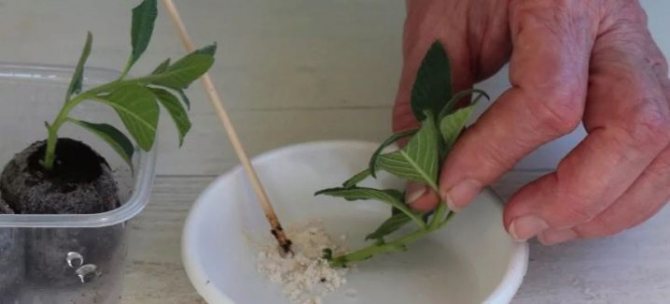

This option is easier and faster, since there is no need to follow the crops and dive them in the future. Cuttings of the Egyptian star are carried out only in the spring.
Seeds
Sowing seed material is very convenient because you can sow it at any time of the year. Process reproduction looks like this:
- drainage is poured into the container with a layer of 3 cm, and on top - soil;
- spill the substrate abundantly with warm soft water;
- grooves with a depth of 5 mm are made on the surface of the soil and seeds are laid out in them; they are not sprinkled with a substrate on top;
- after that, the container with crops is removed to a warm place with a temperature of at least 22 degrees above zero and a humidity of about 60%; if necessary, the surface of the soil is abundantly sprayed from a spray bottle;
- if everything was done correctly, the seedlings will appear in 15–20 days;
- in the future, picking of seedlings is required; carry out the procedure when the first 3 true leaves appear in a plant;
- each pentas seedling is planted in a separate container with a capacity of up to 0.6 liters; care is the same as for seedlings obtained from cuttings.


Questions and answers
- What if the pentas flower began to stretch and lost its stability?
This is due to lack of lighting. In summer, it is recommended to transfer the culture to a brighter place, and in winter - to supplement it with phytolamps.
- Is it possible not to send the culture for the winter dormant period?
If a shrub is grown on a windowsill, it means that the flower definitely needs peace. You can not give a culture to rest only when it grows in the open field.
- Are the pentas leaf plates starting to turn yellow?
The reasons for this are a lack of nitrogen or overdrying of the earthy coma.
How to grow: from planting to grooming
Before growing pentas from seeds, you should choose the right planting material. The seeds must be fresh, as they quickly lose their germination capacity. They should not be processed before sowing.
Prepare the soil for planting the pentasa - it should be light and well structured, with a lot of organic matter. Pour a layer of expanded clay at the bottom of the planting container. Then lay down the soil and compact the surface. Moisten with a spray bottle. Spread the seeds over the surface of the soil and moisten them carefully with spray guns. If the seeds are in a shell, then it is necessary to moisten until the shell dissolves.
Cover the container with crops with plastic wrap and place in a warm, sunny place. Seedlings appear in 5-7 days. They should be carefully watered with drops of warm water daily. In the morning and in the evening, the seedlings should be sprayed with warm water from a spray bottle. The higher the air humidity, the more actively the plant will grow and develop.
In the future, the cultivation of pentas from seeds is reduced to primary and repeated picking. For the first transplant, it is important to choose the right container. It should be no more than 100 ml. After 3 weeks, transplant the seedlings in a 200 ml container. And after 4 weeks after that, transfer to a pot in which the pentas will grow at home.
Pinching is required for this plant at the stage of development of the 6th leaf. Having pinched off the top, start the process of active formation of axillary flower buds. This will speed up the moment of onset of budding and flowering.
Top dressing starts 2 weeks after germination. They need to be done 1 time in 7 days, alternating mineral and organic complexes. It is better to buy ready-made mixtures for flowering plants. Only experienced flower growers can prepare solutions on their own.
Proper care of the pentas in adulthood is described later in the article.
Temperature
In order for the pentas flower to actively develop and delight with beautiful flowering at home, the air temperature in the room must be at least +20 ° C. In winter, the shrub feels great at temperatures up to +16 ° C. Unlike many indoor plants, pentas are not afraid of drafts and sudden temperature changes.
Only gusts of cold wind can harm the plant, which can freeze the leaves, so when you ventilate the room in the cold season, remove the plant from the window. If the temperature is too high for the pentas, it will immediately "report" this with dry tips of leaves and overly elongated stems.
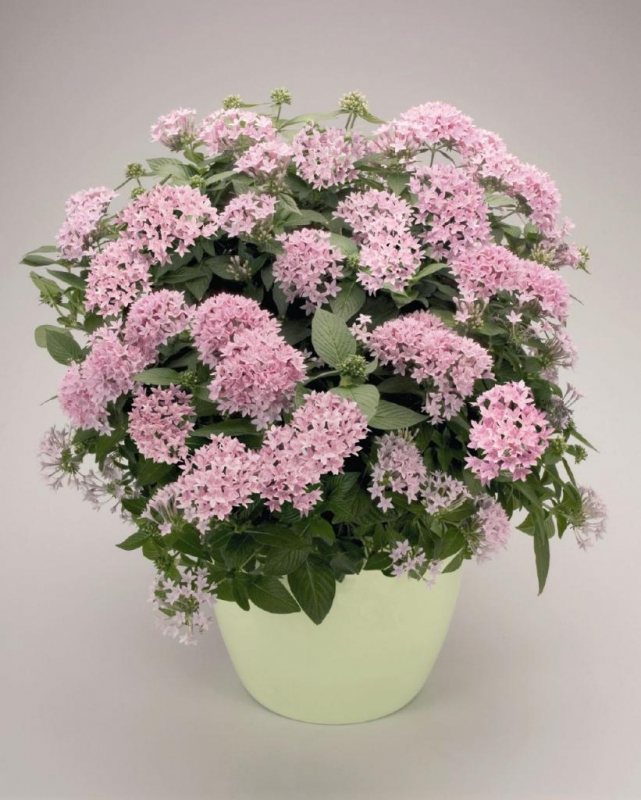

Life Cycles
Winter flowering of this exotic is not obligatory, it can begin to form buds at any time of the year, even in summer. In each case, the question must be resolved individually - whether the perennial growing in the room will live according to its own spontaneous rules, or the one who grows it will establish its own rules.Winter bloom has two great advantages - it is brighter and more lush, and in addition, at this time of year it is especially attractive, desirable and joyful. What do I need to do?
At the end of winter, when the last stars of the flowers fade, you need to pinch the shoots that have escaped from the crown, cut off all wilted buds and transfer the flowerpot to a cold place. It's good if there is a cellar. You need to water very discreetly, so that the soil does not dry out completely. In August, the flowerpot should be moved to its usual place, you can make the planned transplant at this time and, starting from the northern windowsill or from the depths of the room, start accustoming the cultivar to the sun. At the same time, the volume and frequency of watering are gradually increasing. An active growth of greenery is observed, and closer to December, the plant will dissolve its charming inflorescences.
In the future, such drastic measures may no longer be needed, the indoor specimen must enter the rhythm of life dictated to it. However, if it continues to bloom all year round, it is necessary to make it clear with adequate care measures that it is time to rest. Otherwise, its strength will weaken, the buds will bloom spontaneously, and the flowering will be uninteresting and not very decorative.
Transfer
Once you have planted an "Egyptian star" in your house, you should be prepared for frequent transplants, which this culture loves very much. The active growth of lateral aerial shoots and the rapid branching of the root system lead to the fact that the flower soon becomes cramped in the old pot. At the same time, it is highly discouraged to bribe a flower pot "for growth", since this will not immediately affect the flowering in the best way. For active budding, slightly extreme conditions are required, which are created by temperature extremes and cramped dishes. For the first few years, the transplant should be carried out annually; for older specimens, housewarming will be required every 2-3 years. However, it hardly makes sense to keep them for so long without rejuvenation, it gradually grows and loses its visual appeal.
Rejuvenating pruning once every 1 to 2 years will extend the life of the flower and reduce the frequency of necessary transplants.
Caring for pentas during flowering, forming a bush
Pentas blooms throughout the year with short recovery breaks. The cessation of bud formation is a natural process, it is not associated with a lack of watering or illumination. But you can influence him. The flowering of pentasa is extended by applying a special foliar application for flowering indoor plants, which stimulates the formation of buds in the inflorescences.
Stopping feeding stops this process and allows the plant to recover. Stimulating flowering for too long can deplete the flower and the inflorescences become small and sparse. In this case, it is recommended to exclude fertilizers and transfer the flower during the rest period.
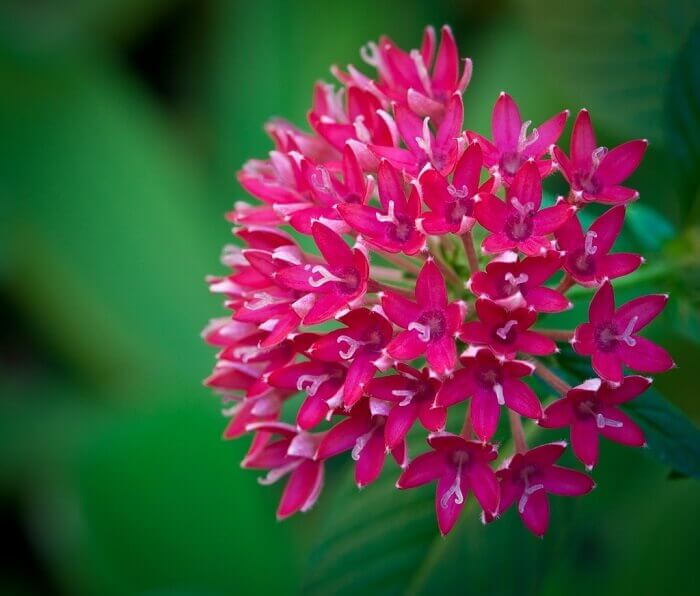

After a break, flowering resumes with renewed vigor: the inflorescences become more lush.
The most natural season for pentas to bloom is from October to November. It is at this time that the plant blooms in the tropics of Africa or Arabia. Summer bloom in indoor cultivation is caused by stimulation with the help of special preparations or saturation of the soil with nutrients.
The stem is strongly stretched in the absence of additional care for the bush. If there are young shoots that spoil the decorative appearance of the trunk, they need to be pinched regularly. But this should be done in the intervals between flowering periods. Thanks to this treatment, the plant becomes more branched, forming a lush herbaceous bush with abundant flowering.
Lighting and placement
This is the most important nuance for abundant flowering. Pentas in the shade is oppressed and blooms less abundantly. But he does not tolerate harsh sunlight, especially after a period of rest.It is best to gradually accustom the flower to bright lighting. In winter, install special phytolamps in dark apartments. So, the plant will bloom throughout the winter season. If you expect flowering in spring, then after winter you can take out a perennial in warm weather on a glazed balcony. The ideal location is the east or south window. For some time, before the flowers appear, it is better to shade the pentas from bright light. As soon as the first inflorescences appear, the shelter can be removed. Carrying out a plant in a summer garden, it must be hidden from strong winds. In winter, short-term ventilation is allowed, but so that a strong cold stream does not affect the plant. Perennial does not tolerate drafts. Under their influence, he sheds foliage and stops growing.
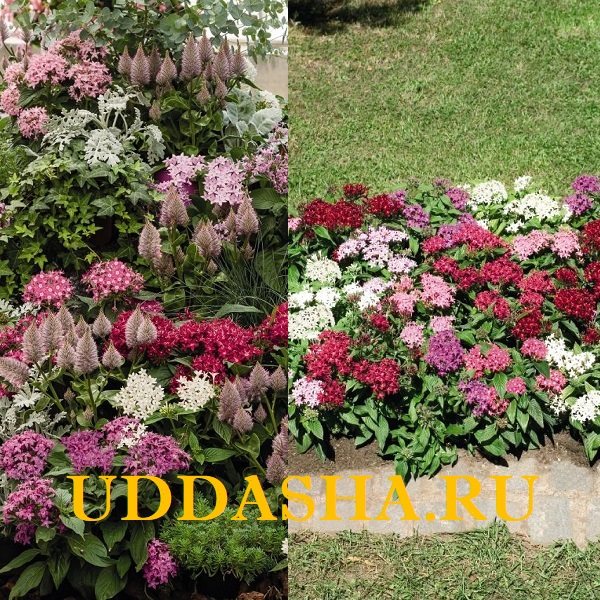

Care and breeding
For growing at home, the most common pentas is lanceolate. It is this type that allows you to get a whole gamut of shades from the plant. Pentas blooms several times per season, periodically stopping the formation of inflorescences.
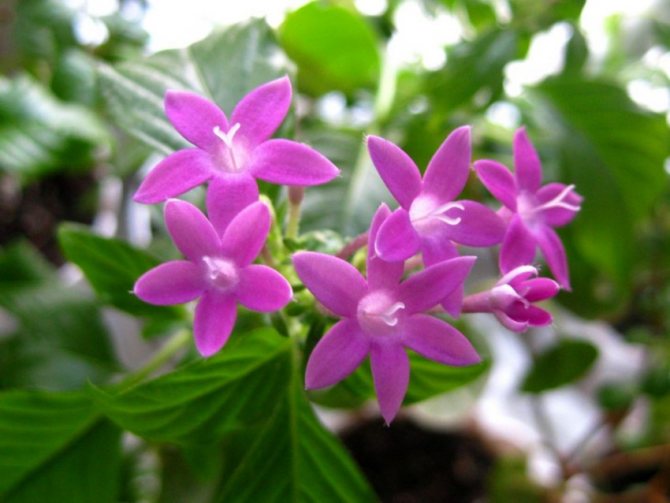

You need to understand that this process is natural and does not depend in any way on the owner of the plant. All he is able to do is to take into account a number of features for caring for a flower in conditions of growing in a garden or at home.
To increase the flowering period, top dressing is used, but do not abuse it, otherwise the flower may "get tired". It is advisable to give the pentas a little rest, which will allow subsequent inflorescences to bloom more magnificently.
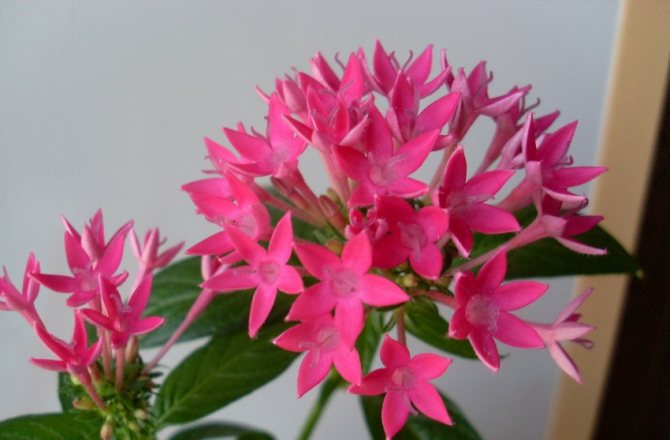

Pentas is very fond of moisture, especially on hot summer days, so in no case should you forget about timely watering. Chlorine-free room temperature water is suitable for this purpose.


Lighting
The plant loves bright light and develops well even in direct sunlight. That is why the sill of the southern window can become his permanent residence. However, you should closely monitor the plant, and if you notice burns on the leaves in the summer, you should shade the window a little. If in winter your flower is very stretched and has lost its stability, this indicates a lack of lighting. During this period, the use of additional illumination is justified.
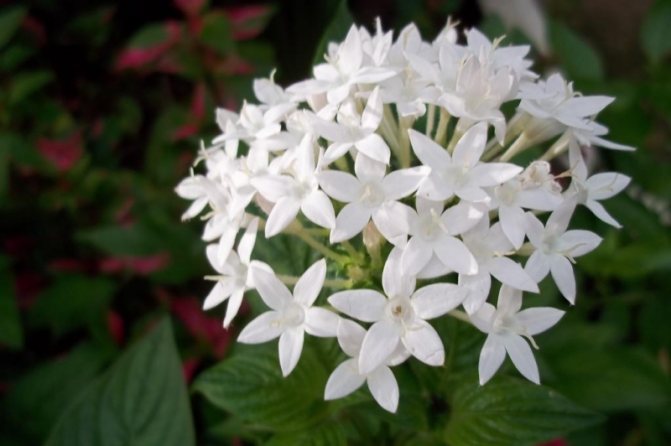

Pentas description
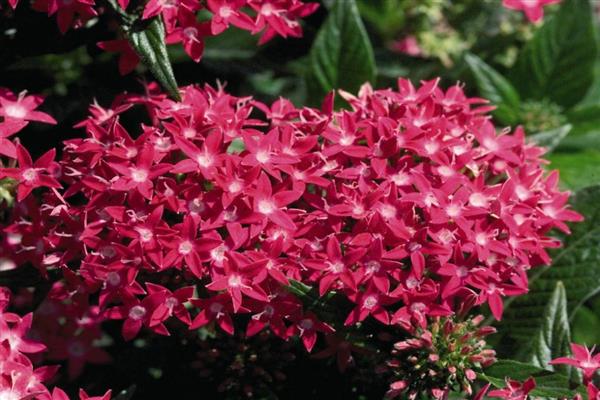

Pentas is an evergreen shrub belonging to the Madder family. The homeland of these perennial and biennial plants is the eastern part of Africa. The Pentas genus includes about 40 different species.
The pentas is characterized by high growth rates: the annual increase in the height of its stems and shoots is from 0.3 to 0.4 m. The stems are, as a rule, straight and strongly branching - as they mature, they become lignified. The foliage is painted in dark shades of green; it is characterized by a lanceolate or spear-shaped plate. The average length of the leaves is about 10 cm. The most common is the opposite or spiral arrangement of glossy leaves. Their surface, like the surface of young shoots, is covered with an edging.
The blooming period of the pentas begins in May and ends in October. The average flowering time of each inflorescence is about 3 weeks. Proper care of the pentas increases the likelihood of re-flowering within one year. Pentasa flowers form umbellate inflorescences located at the tops of the shoots. Their diameter is 10 cm: lush flower umbrellas often hide the foliage of the plant under them. The flowers themselves are not large in size, have the shape of stars with pointed tops of the petals. The pentasa color scheme includes red, pink, white, lilac and salmon shades. Variegated varieties are especially decorative, the leaf plates of which are decorated with a white or pale green border along the contour.
Due to its lush bloom, pentas is often used for landscaping balconies and glazed loggias.Often, flower arrangements are created from various varieties of pentas, located in one container, pot or flowerpot.
Reproduction of pentas
The flower is propagated in two ways: using seeds and cuttings.
Planting seeds is popular because it can be done at any time of the year. Planting material is purchased from a store and placed in moist soil. The container must be placed in a well-lit place and the temperature must be maintained at about 25 degrees. Seedlings will appear in a few weeks.
Sowing pentas:
Cuttings can be obtained during pruning of a shrub, branches longer than 5 cm are suitable. It is recommended to place the prepared pieces of the stem in water for several hours, and then plant them in the ground. The temperature regime should be about 18 degrees. Rooting takes place within 10 days. When full roots are formed, the plants can be transplanted to a permanent place.
Egyptian star pentas charming prey
Fatshedera home care and transplant
Plants that are simple and unpretentious to care for are in demand among summer residents. But experienced gardeners prefer to grow more complex flowers on their plots or at home. These include the pentas. This culture is otherwise called "Egyptian star" or "bouquet in a pot".
Botanical description
The pentas flower is an evergreen flower. It is a member of the Rubiaceae family. Herbaceous or semi-shrub culture native to the subtropical zone. In natural conditions, the flower blooms almost all year round. It is difficult to grow in cold climates and the flowering period is interrupted.
At home, the plant can reach a height of 50 cm. It is characterized by straight shoots that branch slightly. They form wide oval leaves with a bright green color and a length of 5-8 cm. The inflorescences are dome-shaped and consist of small flowers in the form of a five-pointed star. Their colors can be different: white, purple, red, pink or beige.
The lanceolate pentas is usually used as an indoor flower. It can be grown in flowerpots on a windowsill or in a winter garden. In open ground in the middle lane, it can only grow in summer.
Photo of pentos:
Watering and moisture
The plant needs regular watering. Especially often it is necessary to moisten the ground in the summer and with the active growth of the bush. But at the same time, waterlogging of the soil should not be allowed - dampness and stagnation of moisture leads to decay of the roots. Therefore, it is worth watering the flower as the top layer of the soil dries up. It is recommended to use non-chlorinated water for this. In winter, the amount of watering is reduced, since the plant does not bloom and does not need a lot of moisture.
For a culture, the indicator of air humidity is very important, it should be at least 60%. Therefore, it is recommended to place containers filled with water next to the flowerpots, and periodically spray the shrub with a spray bottle
In this case, it is very important to exclude the ingress of water on the flowers.
Soil and top dressing
When growing popular varieties of Pentasa Graffiti, Bussei or others from seed, you need to choose the right soil. Shop mixes prepared for flowering plants are suitable for the flower. But you can prepare the soil yourself using sand, as well as sod and leafy soil. The soil should be fertile and loose, with a little acidity. Drainage is imperative to prevent moisture stagnation and root rot.
The plant should be fed during the flowering period. For these purposes, mineral compositions intended for flowering plants are suitable. They should be applied every 2 weeks. In winter, the pentas does not need feeding.
Pentas lanceolate Graffiti Violet
Crown formation
As it becomes clear from the described pentas care, it is simple and even a beginner in floriculture can do it. But it is much more difficult to ensure not good physical condition, but aesthetics of appearance.His crown is disobedient, and its growth is unpredictable - the shoots are either ugly stretched out, or they are growing in the wrong direction. All these unwanted "body movements" should be promptly suppressed by pinching the tops of the shoots. This should be done more than once a year, like many other indoor crops, but on an ongoing basis due to rapid growth. It is necessary to decide on the desired crown size (optimally about half a meter in diameter) and pinch all the branches that go beyond this volume. If the process is started, the specimen will look disheveled, sloppy and unattractive even during flowering.


Pinching shoots can only be done between budding periods!
Pentasa varieties
For indoor cultivation, any decorative pentasa varieties adapted to low air humidity and low illumination are suitable.
The pentas starla flower is widespread, which has a long flowering period. Lavender Shades has gorgeous lavender petals. It blooms with lush caps.
Other varieties:
- pentas starla "White" - will delight you with exquisite dark green foliage, shading the snow-white buds;
- pentas starla "Deep Rose" - delicate pink inflorescences on stems up to 45 cm high, blooms from March to November;
- pentas starla "Mix" - various shades of buds (white, pink, purple, lavender).
Growing pentasa starla from seeds is a fun process. Seedlings appear within 4 - 6 days. Then comes the active set of deciduous mass. Flowering begins 60 - 70 days after germination. It is possible to grow pentasa starla as an indoor perennial. With the right care, it grows and blooms magnificently for 7 to 8 years.
Popular varieties of pentasa graffiti are Red Velvet, Color Set, Mix, White, Lipstick and others. They are distinguished by their small height and compact arrangement of buds in inflorescences. When growing pentas graffiti from seeds, you should pay attention to its ability to cross. Very often, with repeated vegetative reproduction, so-called chimeras are obtained. This creates space for the selective work of passionate florists.
Watering
An exotic shrub needs abundant and regular watering, especially during the growing season. It is necessary to use only settled water. Watering is carried out after the topsoil dries up. It is dangerous to fill the flower, since the stagnation of moisture in the pot will inevitably cause rotting of the root system of the plant. In winter and during dormancy, when the plant does not bloom, watering is minimal.
In modern indoor floriculture, special flasks are used, which are designed for automatic irrigation. Florists successfully use them to care for pentas in the summer. This is convenient for owners who do not have the opportunity to regularly water their indoor plants or simply forget to do it. The mechanism of these flasks watering the soil in the amount required for each particular pot.


Pentas egyptian star
Depravity is a myth ... LJ Magazine
This is a flower that blooms during periods when there is a lack of sunlight, and there is practically no greenery on the street and gives off the arrival of winter. From October to February, only some ornamental plants standing on the windowsill and not dropping foliage like their distant counterparts that are on the street are pleasing to the eye.
Here one cannot but pay attention to the pentas, which not only warms the soul with the presence of greenery, but simply explodes the consciousness of a person with the appearance of its flowering hat, as if with an explosion of a multi-colored fireworks on New Year's Eve. At the moment of the appearance of such a hat, strewn with inflorescences - five-pointed stars, one cannot help but fall in love with this flower, which seems to say that winter will definitely end
At the moment of the appearance of such a hat, strewn with inflorescences - five-pointed stars, one cannot help falling in love with this flower, which seems to say that winter will definitely end.
Many growers call the pentas a bouquet in a pot or an Egyptian star. One cannot but agree with this, since even one pot with this flower is enough to cheer up. If we consider that a bouquet can have completely different colors, then in this regard it has no equal.
To properly care for the Egyptian star, you should know certain subtleties.
Caring for a pentas at home
Under indoor conditions, to a greater extent, lanceolate (lanceolate) pentas is grown, on the basis of which many hybrids have been bred with various shades. This plant is also interesting because the seeds of the pentasa are of the same color; soon you can get “offspring” with different color shades.
In one season, the pentas can bloom several times, making small stops for rest. If you feed it regularly, then the flowering periods can be increased, but this should not be abused, since this flower constantly needs rest and this can be seen by its appearance. If you give him periods of rest, then the pentas will bloom with renewed vigor every time.
Soil requirements
It is better if this plant will be planted in a ready-made, purchased substrate for decorative deciduous plants. This flower does not like soils in which there are various salts.
Bush shaping
It is necessary to control the growth of the pentas from the first days of planting, as it grows in any unpredictable directions, which leads to a loss of decorative effect. To get a neat bush, you should constantly pinch the shoots that begin to emerge from the aesthetic image of the flower.
Pruning should be carried out in the intervals between its increase.
Leisure conditions
From time to time, Pentas needs to be left alone and he, somewhere in a secluded place, was able to accumulate a little strength and energy. To please others with unique flowering again. But it’s not that easy.
Finding a suitable room for a pentas in the summer is a challenge. The most suitable place for him at this time may be the cellar. Before moving to a cool (relatively cool) location, the flower should be pruned and all buds removed.
Watering should be reduced, but the soil should not dry out.
Somewhere in the month of August, the Egyptian star is taken out of the cellar and transplanted into a new pot, after which it is installed on the north window. After that, the plant needs to be watered more actively. During the autumn period, it is actively growing and gaining strength to bloom again, as before.
Loading…


